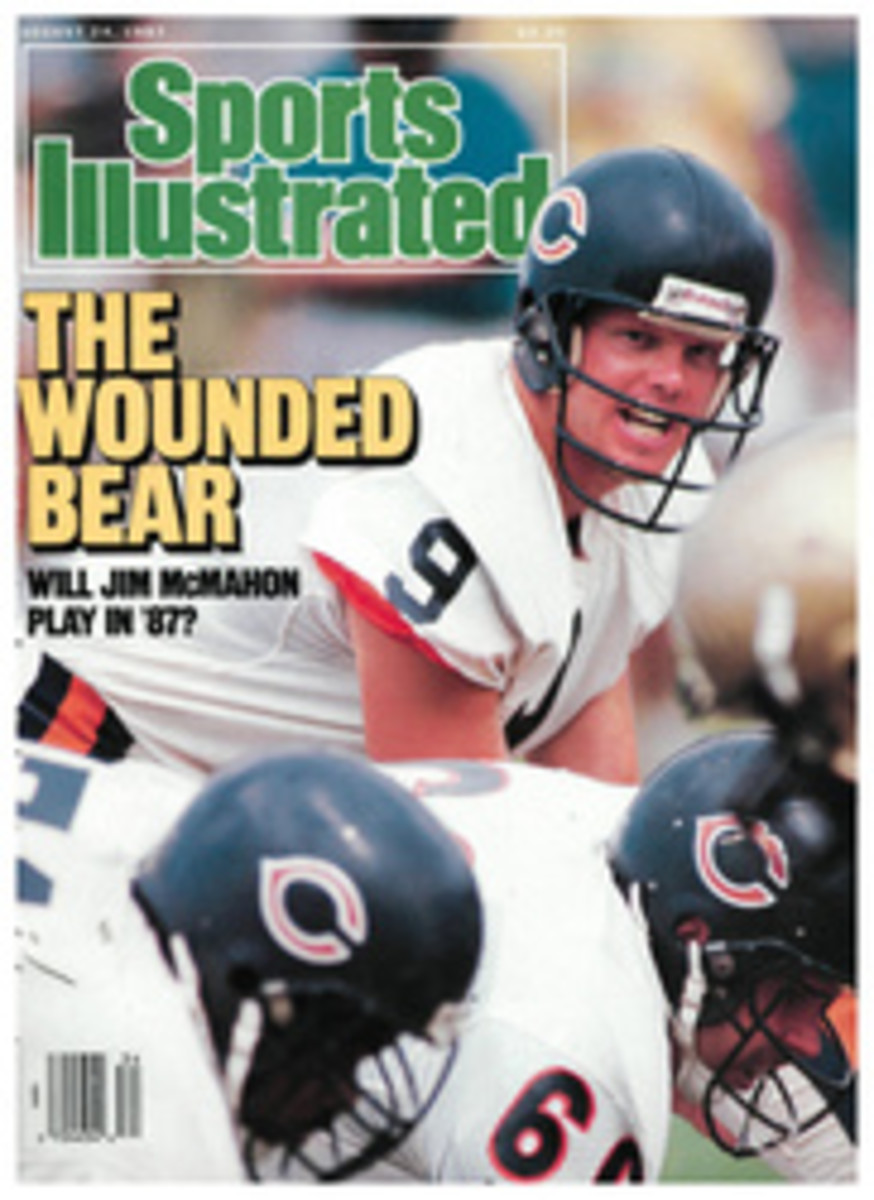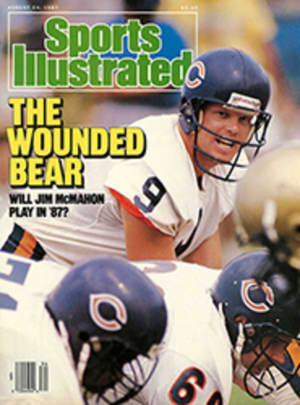
GAMES FROM THE OLD SOD
The big round leather ball that Irishmen call a football bounced and popped downfield, punched from one blue-shirt-ed player to another. Finally, drop-kicked from 10 yards out, the ball sailed toward the goalpost uprights.
"That's a lovely pint!" the announcer exclaimed in a high tenor, meaning "point." The kicker, Charlie Redmond, raised his arms in glee, then dropped them when the white-coated umpire in the end zone failed to wave his flag to signal a score. "Cholly himself seemed ta tink it was a pint, but no!" the announcer continued, though Redmond was already on his way upfield after the ball.
There in Gaelic Park, the grounds of an Irish-American athletic club in Tinley Park, Ill., just southwest of Chicago, young men compete in Gaelic football and hurling matches every Sunday from May to October. They are similar games. They each put 15-man teams on a field that is 140 to 160 yards long and 84 to 100 yards wide, and the object is to propel a ball beneath the eight-foot-high goalpost crossbar (for three points) or over the bar (one point). Gaelic football, the most popular sport in Ireland, looks a lot like a cross between soccer and rugby. Hurling, the Irish national sport, looks like aerial field hockey. A round ball about the size of a baseball is struck by a 42-inch stick, or "hurley," that resembles a whittled-down canoe paddle.
"It's a game well-suited for an Irishman," says Pat Hennessy of hurling. "He's fiery anyway, full of ambition and enterprise." Hennessy is 67. He learned hurling as a youngster in Ireland, played as a schoolboy in Chicago and continued to play it when he returned to his homeland as a young man. From 1936 to 1938 he was on three All-Ireland teams.
On one recent Sunday the Gaelic Park matches featured the County Kerry football team from Ireland—the best team ever, having won eight of the last 10 All-Ireland tournaments—against an all-star team made up of football players from 12 other Irish counties; and the champion hurlers from County Cork against another ail-elsewhere all-star team. In addition, there were exhibition games between teams made up of local players and children.
Harry Costello, 40, is chairman of the North American board of the Gaelic Athletic Association, which had organized the day's events. Though Costello arrived in Chicago from his birthplace in county Limerick 22 years ago, he still has a healthy brogue. And with his red hair and freckles, he was in the majority at Gaelic Park, which looked as if it had been taken over by the Redheaded League. The voices of the 5,000 or so spectators carried the same lilt, and figuring out who among the crowd was born in Ireland and who was born in Chicago was anyone's guess.
Like soccer and rugby, Gaelic football pauses only when the ball goes out-of-bounds or a player has committed a foul, and then just long enough to spot the ball on the sideline and bring it back into play. "It's basically a simple game," says Colm Browne, 30, a policeman from Port Laois in Ireland and a halfback on the all-star team. "It's not like American football, where the coach has a big say and plays can be switched and changed as the game goes on. In Gaelic football everybody gets the ball and uses it constructively."
Players may use their hands, but they may not run more than four steps without playing the ball: either passing by kicking or striking it with a fist or open palm as in a volleyball serve, or by going "toe-to-hand," dribbling it off the tips of their toes as they run. The cuts they make rival the best open-field running in American football; the steals resemble those seen in the NBA, but the hands-off ball control is uniquely precise, with kickers able to pass and score from 30 to 40 yards away. There is plenty of body contact even though the game allows no tackles.
Though amateurs—soccer is the only professional team sport in Ireland—the athletes spend long hours training. "In Kerry," said team coach Mick O'Dwyer, who played 16 years for that county's team, "work revolves around our football. It is the main ambition of every young lad who has been born there to get on the Kerry football team." The Kerry team is composed mostly of professional people, but those players who work for employers tend to find time concessions being made to them for the glory of Kerry.
The Gaelic Athletic Association, based in Dublin, is the international governing body for hurling, Gaelic football, Irish handball and rounders. It also serves as a social organization, particularly in rural areas of Ireland and abroad where there are large emigrant Irish communities. In Ireland, GAA events draw crowds of 80,000 for final events, 40,000 for lesser matches.
"Our organization was founded at a time when Ireland was under English rule," said Liam Mulvihill, director general of the GAA, as bagpipes skirled out a between-game rendition of The Wearing of the Green. "Part of the aim of the organization was to raise the spirit of the people." That was in 1884, when Gaelic football was already a couple of hundred years old.
Hurling actually is an ancestor of Gaelic football and dates back, as the game's lore would have it, to before Christ. Historically, the Irish took their game very seriously. "One parish played another, and there was often war at the end of the game," explained Mulvihill.
I don't know how you could tell; to me hurling itself looks like war. At one point, I saw a player on the Cork team swing his hurley and send a supersonic line drive toward a teammate. An all-star player 15 feet away jumped up and stopped the missile with his gut. The ball plopped to the ground, and he scooped it up with his stick just as a man from Cork rushed him. Dropping his left shoulder, the all-star stunned the onrusher with a vicious body check, then flipped the ball up and batted it 30 yards downfield.
The ball used in hurling is rock-hard, with raised stitches to give it more lift and allow English. It's nearly invisible as it rockets from one side of the field to the other, but good hurlers can catch it bare-handed or pick it out of the sky with their hurleys. Most seem to be able to hit the ball equally well lefthanded or right, and they can balance it on the end of the stick while making broken-field runs. If a player's stick gets knocked out of his hands, he goes after the ball with his feet. The best players can score from 100 yards out and from any angle on the field. The goalie's lot, consequently, is mostly one of frustration: Imagine a baseball batter having to cope with a strike zone 21 feet wide and 8 feet tall.
"When we were kids in Ireland," recalls Hennessy, "we used to go out to an old barnyard and open the barn windows that were two or three stories up, or break them, then try to drive the ball through the windows. First we would do it running to our right, then to our left."
Hurling is said to be the fastest ground game in the world, but hurlers shrug off the potential dangers. Said Tom Cashman, the captain of the Cork team, "The hurley is there to strike the ball but also to protect your face and your hands and your head." Des Donnelly, an architect from County Antrim in Northern Ireland, who played on the all-stars, assured me that "if you're struck by the ball, you're sore for a minute or two, but when you get a score, the pain goes away."
"It's a manly game, as you know," said Hennessy. "We were always taught that if you stay close to your opponent and keep your stick up in front of you, you never get badly injured. I ignored that advice one time, and I paid the penalty—five stitches over the head. We were coming in for the ball, and I pulled for the ball and my opponent pulled for the ball and he got my head. I was stretched out on the sidelines, and stitched there, too."
"We're encouraging them to wear helmets with face guards," Mulvihill told me. "It keeps them from losing their teeth." There were a few helmets on the field that day, but more than a few gap-toothed smiles.
The fun and carnage came to an end just as a thunderstorm rolled in and drove the spectators to their cars. As the satiated fans of Gaelic football and hurling headed back to their homes in Chicago and its suburbs, one could now hear midwestern accents replacing the brogues that had been left behind until the next visit to Gaelic Park.
TWO ILLUSTRATIONS
RICHARD EGIELSKI
Michael Kiefer is a free-lance writer, based in Chicago, who specializes in offbeat sports.

